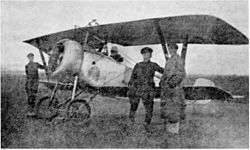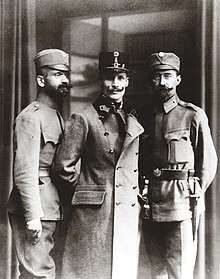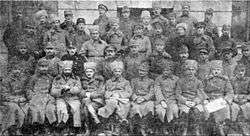Ukrainian Galician Army
Ukrainian Galician Army (Ukrainian: Українська Галицька Армія, romanized: Ukrayins’ka Halyts’ka Armiya, UHA), was the Ukrainian military of the West Ukrainian National Republic during and after the Polish-Ukrainian War.
| Military History of Ukraine |
|---|
|
|
|
|
|
|
|
|
|
|
|
|
|
|
|
|
|
|
|
|
|
|
|
|
|
|
|
|
|
|
|
|
|
|
|
Military equipment
The Ukrainian Galician Army obtained its arms from Austrian depots and from the demobilized Austrian and German troops who streamed through Galicia by the hundreds of thousands following the collapse of the Central Powers at the end of World War I. However, the centers of Austria's military industry lay far from Galicia, and subsequent difficulty with resupply was a major factor in the Galicians losing their war against Poland.
Armed Forces


The government of the West Ukrainian People's Republic was well organized and was able to mobilize over 100,000 people by spring 1919, 40,000 of whom were battle-ready. Due to the Ukrainians' generally poor socioeconomic status, the army had a disproportionately low ratio of officers to other ranks. In the Austro-Hungarian Army, ethnic Ukrainians had accounted for only two out of 1,000 officers (in comparison, Poles had made up 27/1,000 officers in the Austrian military). As a result, although most of the junior rank officers were Galicians the government of the West Ukrainian People's Republic relied largely on former high-ranking officers of the defunct Russian Army, such as General Mykhailo Omelianovych-Pavlenko, to take on the post of commander and general staff. It also staffed many positions with unemployed Austrian and German officers. For this reason, the German language was the easiest way for officers to communicate with each other and was the dominant language among the staff.[1] Despite these measures, only approximately 2.4% of the army consisted of officers.

The Ukrainian Galician Army reached its greatest strength in June 1919, where it had 70,000 to 75,000 men, including reserves. It had very limited cavalry but artillery, consisting of ex-Austrian pieces, was a strong point. The UHA had 2-3 armored cars and two armored trains. The UHA's air force, organized by Petro Franko (son of the poet Ivan Franko), fielded 40 airplanes, and until April 1919 enjoyed air superiority over the Polish forces.
Sich Riflemen
A former unit of the Austro-Hungarian Army, the 1st Brigade of Sich Riflemen (Січові Стрільці) became the elite force of the Ukrainian Galician Army during the war against Poland. It was formed in 1914 by former members of youth and paramilitary organizations and fought in Galicia and Ukraine against the Russian Empire throughout the first world war. At its peak this brigade had 8,600 men, not all of whom fought in Galicia.
Jewish Battalion
The Ukrainian Galician Army fielded a Jewish battalion (Zhydivs’kyy Kurin’ UHA) recruited from Jewish university and high school students in Ternopil and led by Lieutenant Solomon Leimberg.[2] Formed in June, 1919, it attained a strength of 1,200 men and participated in combat against Polish forces in July 1919 and subsequently against the Bolsheviks. The battalion was decimated by a typhus epidemic in late 1919 and its surviving soldiers were subsequently reassigned to other units within the Ukrainian Galician Army.[3]
Structure
The Army consisted of numerous military formations which later were organized into four Corps. The Corps were farther divided into brigades composed of several regular military units.
- I Corps UHA
- 5th Sokal Brigade
- 6th Rava Brigade
- 9th Uhniv-Belz Brigade
- 10th Yavoriv Brigade
- II Corps UHA
- Legion of Ukrainian Sich Riflemen
- 2nd Kolomyia Brigade
- 3rd Berezhany Brigade
- 4th Zolochiv Brigade
- III Corps UHA
- 1st Mountainous Brigade
- 7th Stryi Brigade
- 8th Sambir Brigade
- Battle groups "Krukevychi" and "Hlyboka", reformed into 11th Stryi Brigade
- 14th Brigade (later)
- IV Corps UHA
- 12th Brigade
- 21st Zbarazh Brigade
Territorially the West Ukrainian People's Republic was divided into three Military Oblasts centered in Lviv, Tarnopil, and Stanyslaviv with four okrugas (districts) in each.
Notable Soldiers of the Ukrainian Galician Army
- Archduke Wilhelm of Austria, Austrian Archduke
- Petro Franko, son of Ukrainian writer Ivan Franko
- Oleksander Hrekov, commander-in-chief, ethnic Russian former Tsarist general, architect of the Chortkiv offensive
- Yevhen Konovalets, founder and first leader of the Organization of Ukrainian Nationalists
- Mykhailo Omelianovych-Pavlenko, Supreme Commander, later defence minister of the Ukrainian People's Republic's government-in-exile
- Hnat Stefaniv, commander of Ukrainian forces in Lviv and later commander of the Ukrainian army in exile
- Myron Tarnavsky, supreme commander of the Ukrainian Galician Army during its successful anti-Bolshevik offensive on Kiev; courtmartialed for signing an agreement with Anton Denikin
- Dmytro Vitovsky, organizer of the Ukrainian uprising in Lviv and special operations formations. Later he was a member of Western Ukrainian delegation to the Paris Peace Conference in May 1919
See also
- Polish-Ukrainian war
References
- Yaroslav Tinchenko, General Oleksander Hrekiv: Military Actions and Fate Journal of Memorial pg. 33 Archived 2011-06-14 at the Wayback Machine (Ukrainian)
- Myroslav Shkandrij. (2009). Jews in Ukrainian literature: representation and identity. New Haven: Yale University Press. pp.94-95
- Encyclopedia of Ukraine, vol. 2 1989
- Subtelny, Orest (1988). Ukraine: A History. Toronto: University of Toronto Press. ISBN 0-8020-5808-6.
- A web site including information about the Ukrainian Galician army